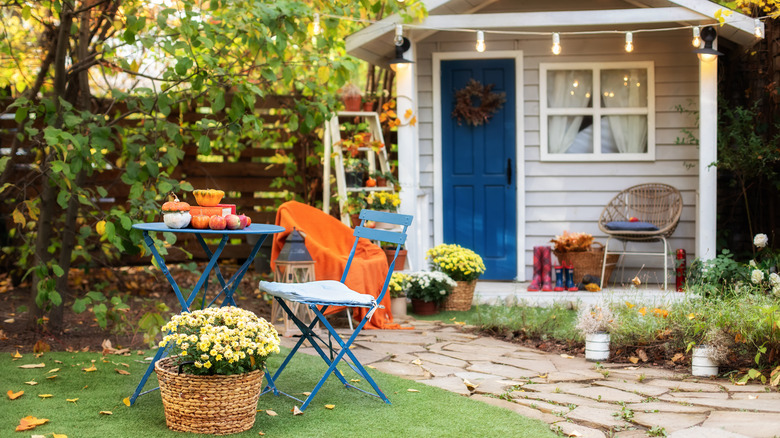

If you want to have lush grass and healthy plants next season, knowing how to prepare your yard for fall and sticking to a strict lawn care calendar is essential. In this article, our professional gardening experts will teach you how to design a garden and develop the best landscape plan for your outdoor space.
Keep on reading for the ultimate tips on how to set up and execute big and small garden plans for fall.
As the fall season approaches, so do the necessary garden and lawn maintenance tasks. Indeed, to prepare your garden for the new season and plant your fall greens on time, you might have to put in some extra time and effort, but it is all worth it.
The first thing on your lawn care calendar and landscape plan this fall should be the removal of diseased, withered, and dead plants. Why is this task important? Because dead greenery is almost as bad as weeds. It is suffocating your lively plants, looks visually unpleasant, and offers perfect conditions to harbor pests and spread plant diseases.
It is best to cut away lifeless leaves, dormant stems, or brownish and yellowish growth at the earliest opportunity. When possible, pluck dead leaves or stems by hand at the moment you see them, but be careful not to harm your plant by pulling too hard.
Another vital task to execute a fall season landscape plan is pruning. Especially when it comes to trees. The procedure is removing unhealthy branches and dead leaves with the help of pruning shears or other trimming tools. This gardening job is a necessity that will help keep your trees in their best condition.
A tree canopy’s shape and aesthetic appeal can be easily maintained by pruning. But aside from improving the appearance of your tree, this can also reduce leaf clutter, as well as encourage new healthy growth.
Our next piece of advice is to add soil tilling to your landscape plan and lawn care calendar. Why is it necessary? Because usually, a landscaping plan includes the process of planting new ornamentals and edibles. And unless you till the soil and mix in the nutrient-rich matter, you may have trouble growing any ground crops without planters and raised beds.
During tilling, you are mixing organic matter into the ground soil, preventing weed growth, dislodging crusted dirt, and loosening up the soil in the designated area for planting. Please note that the soil does not need to be tilled or broken up very deeply; it is best to break it up less than 30 cm (12 inches) deep.
Seed conservation after the summer harvest is something that also deserves an enthusiast gardener’s attention. It encourages the preservation of your favorite open-pollinated and summer heirloom varieties while helping you save a lot of money. With that in mind, saving seeds should definitely be present in your landscape plan and lawn care calendar for the fall season.
The next vital garden task for the fall is lawn maintenance. Following a lawn care calendar will help you keep your beautiful lush grass as green as possible for as long as possible before winter hits. Here are a few lawn care tasks to think about by month:
A lawn care calendar is the difference between a regular lawn and a healthy lawn all year round.
Speaking of the best plants to add to your landscape plan this fall, we cannot forget to mention lettuce. Beginners love this crop, as the wonderful leafy vegetable is hardy, extremely easy to grow, develops rapidly, and promises a long harvest period. Lettuce can be grown in almost any condition, however, the plant prefers full sun, loose soil, high humidity, and cool temperatures.
Carrots are crops that you should certainly consider in your landscape plan. These super delicious root vegetables thrive in fall and would grow in no time. Fertile soil with good drainage qualities and full sun are the best conditions for ultimate carrot growth. To ensure healthy development, inspect the planting area and remove any stones and weeds from the soil before sowing. Avoid planting in stony, shallow, or clay soil.
What is a fall landscape plan without broccoli? This green edible is the perfect fast-growing fall plant to have in your veggie garden. If you plan to cultivate broccoli, make sure the soil is fertile, well-drained, slightly acidic, and that it contains a great amount of organic matter. The vegetable likes full sun exposure and relatively cool temperatures. Consider adding mulch.
A wonderful way to make the most of your landscape plan is by planting kale. Even though this vegetable is not super popular, it is one of the best hardy plants you can have in your garden and harvest in the fall. Plant it in well-drained loamy soil with organic matter. Kale grows the best in full sun, but partial shade is also tolerable.
When it comes to fall plants, cabbage is a classic green vegetable that always comes to mind. It is so robust and easy to grow that even novice gardeners can cultivate it without any problem. For the best growth, plant the cabbage in a full-sun spot in moisture-retentive loam soil, mixed with compost. When watering, water at the base and keep the foliage dry.
Another worthy plant to have in mind for your fall landscape plan is turnips. In colder climates, these hardy veggies can survive a frost and will grow regardless of the temperature. However, if you plan on growing them as fall plants, note that turnips develop best in full sun and well-drained fertile soil with compost.
We hope our fall gardening advice was helpful! If you still need help with your lawn care calendar and landscape plan for the upcoming season, get in touch with our team of experienced gardening professionals in West London. We have all the right garden tools, practical skills, and knowledge to help you transform your garden and reach its potential for the colder months.

Meet Nikolay, a talented blog and content writer with years of experience creating engaging and informative content for a variety of industries.


TO CELEBRATE OUR NEW WEBSITE WE WANT TO GIVE YOU
